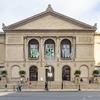More about The Millinery Shop
- All
- Info
- Shop

Contributor
Edgar Degas went through fifteen iterations of this subject during the 1880s using different media and scales. Out of all of them, this piece is the largest.
Degas had an interest in shopping, fostered by observing women on their day to day errands, noting down their attention to detail and discriminating selection process. He even went hat shopping with artist Mary Cassatt and her friend, Madame Emile Strauss. He was especially fixated with the chapeau - the extravagant, crowning piece of any woman’s ensemble and the 1880s equivalent of Yeezys or a Louis Vuitton duffle bag. Each chapeau was custom-made and very expensive, and it was this piece of headwear and the places it was sold that dominated Degas' work from the 1870s to 1910.
Originally, the woman was meant to be a customer trying on hats, but later renditions (this one included) imply the woman worked at the shop and had a hand making the hats. Degas usually shows clear indications of who was the customer and who worked at the hat shop, but this piece’s subject’s relationship to the hats was deliberately left ambiguous. Like most of Degas’ women, she seems unaware of the painter. It's a quality that you could find nowadays in most street photography or photojournalism work. This was either intentional or Degas was a bit obsessive and lowkey creepy in his fixation toward millinery shops and women. Or both.
The first owner of the The Millinery Shop, Paul Durand-Ruel, single-handedly brought the Impressionist movement into the limelight. Seeking new artists to fill the halls of a gallery he bought in London in 1870, he stumbled upon Claude Monet and Camille Pissarro. He bought their paintings, saving them from financial trouble, but did not foresee much success for them in Europe due to their styles going against the popular Academic style. It wasn’t until ten years later, in an exhibition in New York, that they received a warmer reception to their work. Once America cozied up to the Impressionists, Paris followed suit, and fame soon followed. Money talks, and the art world answered.
Sources
- Ferreira, Rute. 2018. “The Story Of The Art Dealer Durand-Ruel, The Man Behind Impressionism.” DailyArtMagazine.com - Art History Stories. February 20, 2018. http://www.dailyartmagazine.com/art-dealer-durand-ruel/.
- Groom, Gloria Lynn. 2012. “Edgar Degas - The Millinery Shop.” Essay. In Impressionism, Fashion, & Modernity. Chicago, NY: The Art Institute of Chicago. https://news.wttw.com/sites/default/files/article/file-attachments/Edgar Degas-The Millinery Shop.pdf.
Featured Content
Here is what Wikipedia says about The Millinery Shop
The Millinery Shop is an oil on canvas painting by the French Impressionist artist Edgar Degas created between 1879 and 1886. At 100 x 110.7 cm, it is the largest work Degas created on the subject of milliners. It illustrates a young woman, perhaps a milliner or a customer, seated at a table with five hats on wooden stands. It is located at the Art Institute of Chicago.
Check out the full Wikipedia article about The Millinery Shop













